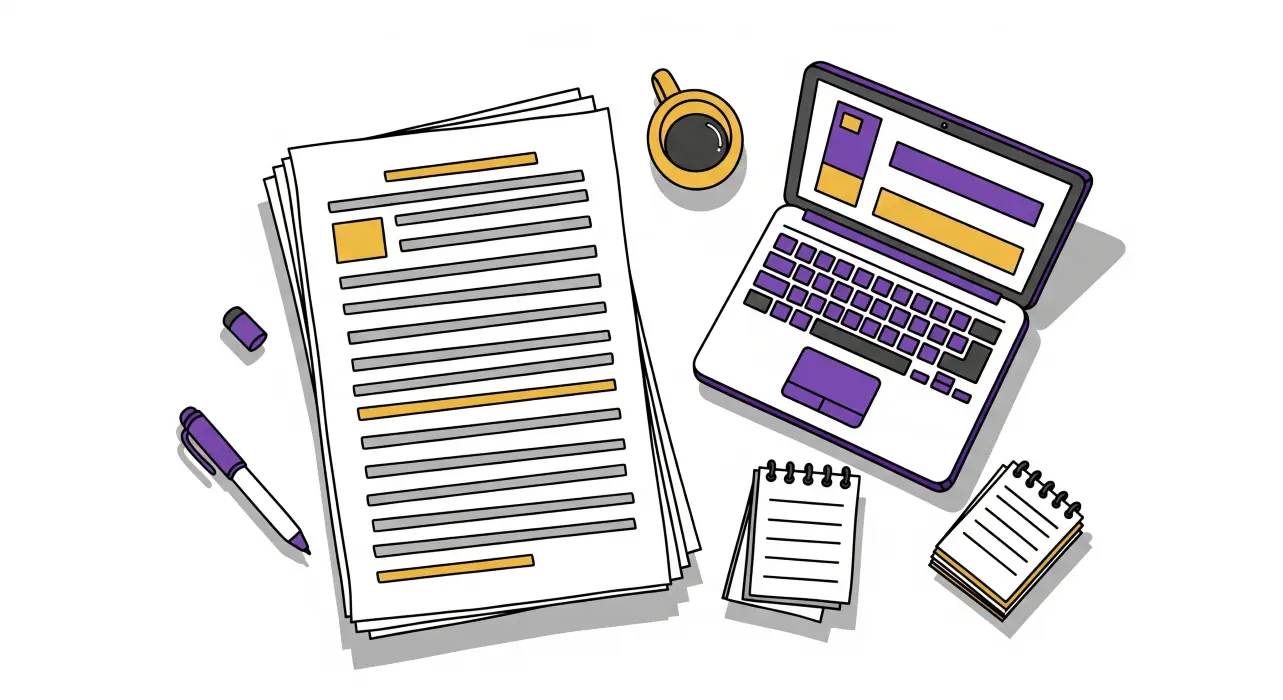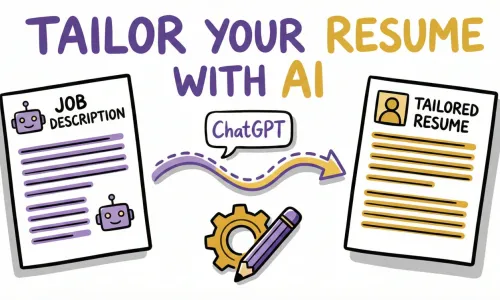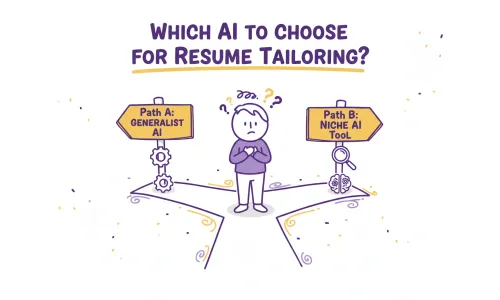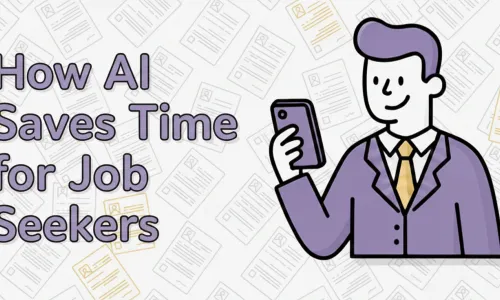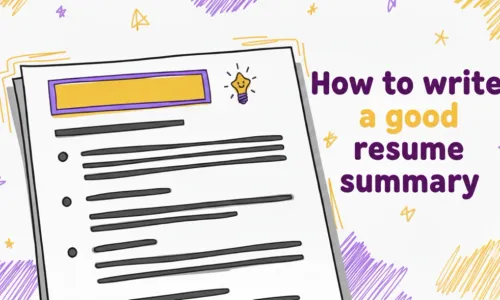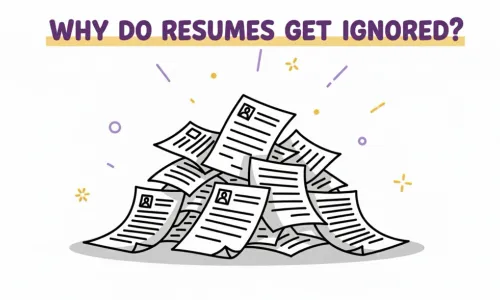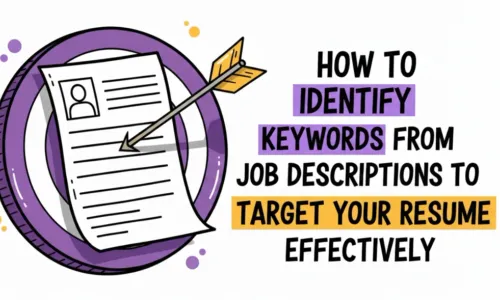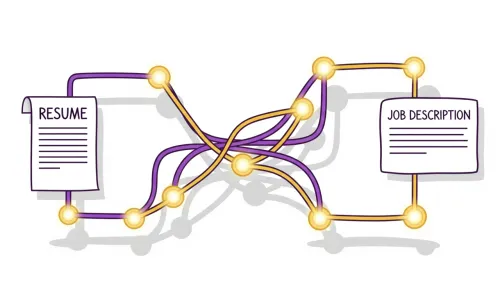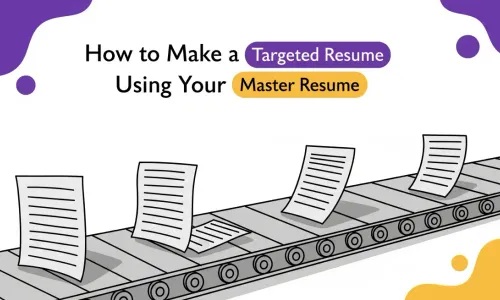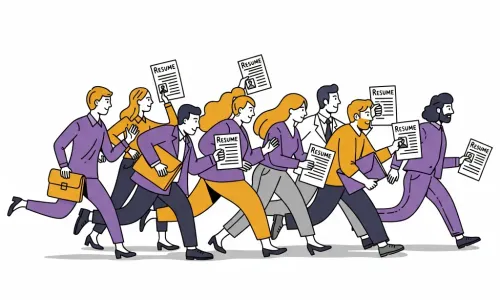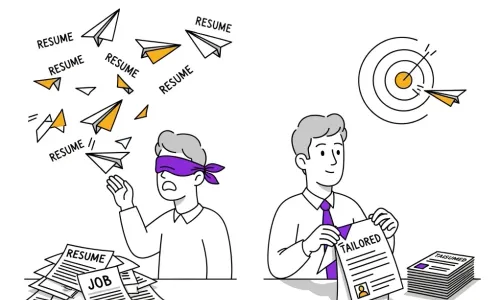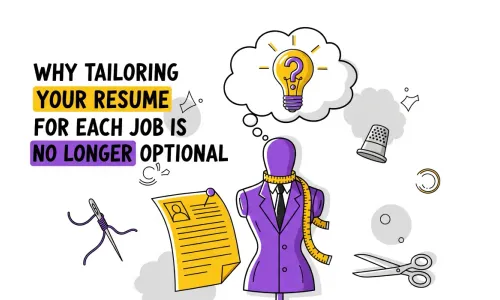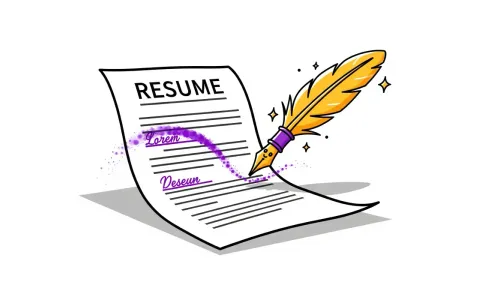Are you tired of sending out your resume and never hearing back? It’s time to target your resume—learn how to write a targeted resume that is worded precisely to each job description and catches the eye of recruiters, hiring managers, and even LinkedIn’s search algorithms.
Most companies, including the majority of large organizations, use Applicant Tracking Systems (ATS) to screen resumes, so targeting your resume for each application is crucial to ensure it gets seen.
In this article, you’ll discover why tailoring your resume to a job posting is essential, how using the right keywords helps you beat the applicant tracking system (ATS), and actionable steps to create a resume that increases your chances of getting interviews. Plus, we’ll show you how to streamline the whole process using Reztune: a smart resume-tailoring tool that instantly delivers a job-ready, ATS-friendly resume without manual hassle.
1. Introduction to Resume Building
Building a great resume isn’t just about listing your work experience and hoping it fits somewhere. Today’s job market is highly competitive, and recruiters and hiring managers are inundated with resumes for every open position. Companies receive high volumes of job applications and use Applicant Tracking Systems (ATS) to manage and screen these submissions efficiently. That’s why you need a resume that highlights your most relevant skills, showcases your experience succinctly, and closely matches the requirements of the job you’re applying for.
A resume is more than a summary of past jobs—it’s your marketing pitch. This document should be tailored to ensure your resume aligns with what each employer is looking for in a particular job posting. When your resume is worded thoughtfully and contains the right keywords, it stands out both to people and to automated bots screening applicants. Career counselors can also assist job seekers in optimizing their resumes for ATS, improving match rates, and navigating the job application process more effectively.
2. Why Target Your Resume for Every Job Application?
If you’re using the same general resume for every job application, you’re missing out on job opportunities. Recruiters and hiring managers are looking for candidates who fit the job description exactly. When you tailor your resume for each specific job, you greatly increase your chances of being seen as a strong fit for the role.
A targeted resume is a customized version of your resume designed for a specific job opening. It reflects how your skills and experience are relevant to the employer’s needs as listed in the job description. As a result, you’re more likely to get past applicant tracking systems (ATS) and into the hands of someone who can get you an interview. Large companies, in particular, rely on ATS to filter and evaluate applications, so tailoring your resume with relevant keywords is crucial to succeed in their recruitment process.
Making a targeted resume for every job application may sound time-consuming, but tools like Reztune help you make a targeted resume instantly. This way, you can apply for any job with a resume that’s already optimized for the posting—and you’ll never have to worry about missing out because your qualifications were hidden in a generic resume.
3. What is a Targeted Resume, and Why Is It Better Than a Generic Resume?
A targeted resume shows the employer why you’re the perfect fit for the job by emphasizing experience and skills that directly relate to the job requirements. This is different from a general resume, which lists all your qualifications without adapting to the needs of a specific role.
When you write a targeted resume, you reference the job description heavily, pulling in keywords, skills, and even phrases directly from the ad. Including the relevant job title from the job description is also crucial, as it helps improve ATS compatibility and ensures your resume is recognized for the correct position. For example, if the job description mentions “project management skills” and “experience with specific software,” both terms should appear in your work experience and skills section.
Targeted resume examples demonstrate how a customized resume gets better results: candidates see more callbacks and interviews because recruiters and ATS both notice resumes that align closely with the job posting. The result? You move one step closer to your dream job with every application.
4. How to Analyze a Job Description for Important Keywords
Before you even edit one section of your resume, look at the job description carefully. The best way to create a targeted resume is by identifying the “resume keywords” the employer uses to define their specific job requirements. These might include job titles, soft skills, hard skills, qualifications, or even key phrases like “client-facing experience” or “proficiency in ATS software.”
Highlight qualifications and duties that repeat or are clearly required—for example, “leadership,” “budget management,” or “salesforce CRM.” Your resume should reflect these abilities in both your summary and your work experience section.
Some resume matchers and resume scanners can automatically pick out keywords, but this process is also about understanding which skills are most relevant to the job. Use your findings to ensure your resume template mirrors the language and priorities of the job description, boosting both your chances with recruiters and with the applicant tracking system.
Analyzing the job description can also help you identify any missing skills in your resume compared to the job requirements, allowing you to address these gaps and better tailor your application.
5. Copy and Paste Strategy: Extracting Key Phrases from Job Descriptions
One of the most effective ways to tailor your resume for a specific job is to use the copy and paste strategy. Start by carefully reading the job description and identifying the most important keywords, job titles, and skills that the employer is seeking. Copy these key phrases directly from the job listing and paste them into relevant sections of your resume, such as your summary, skills, and work experience.
This approach ensures your resume contains the exact language that applicant tracking systems (ATS) and hiring managers are looking for. Using a resume scanner or ATS resume tool can help you pinpoint which keywords and phrases are most important for the specific job posting, boosting your match score and making your resume more likely to pass through ATS filters.
By customizing your resume for each job application—rather than using the same resume every time—you demonstrate to employers that you have the specific skills and qualifications they need. This targeted approach not only increases your chances of getting noticed but also helps you create a new resume that is perfectly aligned with the requirements of each specific job description.
6. How Do Applicant Tracking Systems (ATS) Work?
Over 95% of large employers—and many smaller ones—use applicant tracking systems as their first round of resume review. An applicant tracking system (ATS) scans your resume, compares it to the job description, and assigns it a “match score.” Only the best-matched resumes make it to the hiring manager.
If your resume is missing the skills and keywords from the job description, the ATS will simply filter out your application. This is why an ats resume, optimized with exactly the right terms, increases your chances of getting an interview.
Formatting also matters. Complex layouts, graphics, or unusual fonts can confuse ATS software. Using a standard, clear format for every section of your resume helps the software extract your qualifications and deliver your application to a recruiter. This also ensures that ATS software can accurately parse your resume and extract relevant information.
7. How to Create an ATS Resume That Gets Noticed
Creating an ATS resume means optimizing every word with the right keywords and formatting your achievements so they are easy for both ATS and people to read. First, include skills, qualifications, and experiences that appear in the job ad. These keywords should appear naturally in the professional summary, skills section, and work experience.
Next, use a resume template that keeps headings like “Professional Experience,” “Education,” and “Skills” clear. Avoid using tables or graphics, as these can block ATS from reading key information. Also, use full titles and relevant certifications as listed in the job description so that your resume is aligned with the job.
To save time and ensure your resume is always worded perfectly, Reztune instantly generates ATS-ready resumes based on your existing document and the specific job description. You just upload your resume, paste the job description, and receive a ready-to-send, formatted document with zero manual effort.
Optimizing your resume with the right keywords and formatting increases your chances of being identified as one of the qualified candidates by ATS.
8. What Skills Should Your Resume Contain for Maximum Impact?
The skills section of your resume is your quick way to prove you’re a great fit for the role. Read the job description and cherry-pick both hard skills (like “JavaScript” or “data analysis”) and soft skills (“communication” or “problem-solving”) the employer is looking for. These are the same skills the job listing is likely to require from candidates.
Don’t overlook the importance of adding skills your resume is missing if they match your experience and are requested in the job description. If you’re changing fields or have transferable skills, explain how those are relevant to the job in your work experience section.
To get an even clearer picture, use the Compare Resume function in a tool like Reztune, which shows you exactly which skills and keywords your resume contains and what’s missing compared to the specific job posting. That way, you can fill gaps and ensure your resume highlights everything that will get you noticed. Including more relevant keywords and skills can lead to more matches in ATS, increasing your chances of being noticed by hiring managers.
9. What Are Common Resume Mistakes That Decrease Your Chances?
The biggest mistake job seekers make is using the same resume for every job. A generic resume rarely aligns with the job description and often misses out on important keywords. This means it’s less likely to pass ATS or catch the attention of recruiters and hiring managers.
Another mistake is poor formatting or spelling errors, which makes your resume look unprofessional and may cause applicant tracking systems to misread your qualifications. Also, focusing too much on duties instead of achievements in your work experience can undersell your value.
Lastly, failing to showcase how your skills and experience relate to the job you’re applying for—by not tailoring your resume—can be a dealbreaker. Use a targeted resume for every job application, applying the lessons from this article, and avoid these pitfalls. Optimizing your resume for ATS increases your chances of being selected for job interviews.
10. How to Use Resume Tools Like Reztune to Instantly Make a Targeted Resume
One of the hardest parts of resume building is manually aligning your resume to fit every job application. This takes time, energy, and attention to detail. But with Reztune, you can create a targeted resume in just seconds. Here’s how it works:
- Upload Your Resume and Paste the Job Description: Reztune scans both, extracting key details about your experience and the specific job requirements, and provides an instant match score to show how well your resume aligns with the job.
- Instantly Receive a Targeted, ATS-Ready Resume: Unlike most resume builders that require you to click through endless forms, Reztune produces your job-ready document instantly—with professional formatting, relevant keywords, and the perfect length.
- Increase Your Chances of Getting Interviews: Reztune’s AI matches your qualifications to every section of your resume, so you can apply confidently and quickly. You get a resume that highlights your greatest achievements and skills for the specific job posting, boosting your odds of getting noticed by both ATS and humans.
Whether you’re starting your job hunt, changing industries, or pursuing your dream job, Reztune saves you time and maximizes your potential. With its unique approach, you can ensure your resume matches every job offer without manual edits.
11. How to Compare Your Resume to the Job Description and Improve
Simply writing a resume isn’t enough—compare your resume to the job description using either manual techniques or resume tools. This process unveils the skills your resume is missing and helps you ensure your resume aligns with the employer’s needs.
To do this manually, list out all the qualifications, skills, and experiences requested in the job ad. Next, check each item against your resume. Does your resume worded closely match these requirements? If not, revise until your document incorporates these elements without exaggerating or misrepresenting your experience.
With tools like Reztune, this comparison happens in the background. The app automatically scans the requirements of the job, reviews your resume, and makes sure the ATS and recruiter see a resume that is a top fit for the job you’re applying to. Making these improvements can result in a higher score in ATS, increasing your likelihood of advancing in the hiring process.
12. The Hiring Process: What Happens After You Apply?
After you submit your job application, your resume enters the hiring process, which typically begins with applicant tracking systems (ATS). These systems scan your resume, comparing it to the job description to determine if you’re a good match for the role. Using an ATS resume checker before you apply can help you optimize your resume for this crucial first step, ensuring your relevant skills and keywords are front and center.
If your resume passes the ATS screening, it moves on to hiring managers and recruiters, who review your qualifications and experience in more detail. At this stage, a well-tailored resume that matches the job description can set you apart from other candidates and increase your chances of being selected for interviews.
Understanding how the recruitment process works—and the role of ATS systems—empowers you to tailor your resume and cover letter for each job. By leveraging tools like resume scanners and job description matchers, you can create a tailored resume that highlights your strengths and maximizes your chances of progressing through each stage of the hiring process.
13. Finalizing Your Resume with a Free Account: Last Steps Before You Submit
Before you hit “submit” on your job application, take advantage of a free account to finalize your resume and make any last-minute improvements. Many platforms offer a free resume review, giving you instant feedback on your resume’s strengths and areas for improvement. This step is essential for ensuring your resume aligns with the job description and meets the requirements of applicant tracking systems (ATS).
Use a resume matcher tool to compare your resume to the specific job posting, checking for keyword density, formatting, and relevance. Adjust your resume as needed to increase your match score and make sure your skills and experience are clearly highlighted. Artificial intelligence-powered tools can help you optimize your resume for ATS, ensuring it’s both ATS-friendly and appealing to hiring managers.
By taking these final steps with a free account, you can create a tailored resume that stands out in the hiring process, increases your chances of landing more interviews, and helps you move closer to your next job opportunity.
14. Summary—Key Takeaways for Your Next Job Hunt
- Every job application needs a targeted resume: Don’t use a generic resume for every job.
- Most companies use ATS to screen resumes: Companies rely on applicant tracking systems to filter candidates, so it’s essential to target your resume for each application.
- Read the job description carefully: Identify all relevant skills, keywords, and qualifications.
- Match your resume to the job description: Make sure your resume contains the keywords and skills listed in the job ad.
- Create an ATS-ready resume: Use standard formatting and ensure important information is easy for applicant tracking systems to extract.
- Don’t forget the skills section: Include hard and soft skills relevant to the specific job.
- Avoid common mistakes: No typos, no generic content, and always focus on achievements, not just duties.
- Use a resume tool like Reztune: Instantly generate a perfectly formatted, keyword-optimized resume with no manual effort, so you can apply faster and increase your chances of landing interviews.
- Compare your resume to each job posting: Always ensure your resume aligns with the requirements and company culture for every job opportunity.
- Your resume is your marketing tool: Make it count—customize every section for the specific role.
Start applying these steps today and watch your job interview opportunities grow. And if you want to skip the hassle, give Reztune a try and let AI handle resume targeting, formatting, and keyword matching, so you can get your dream job faster!

